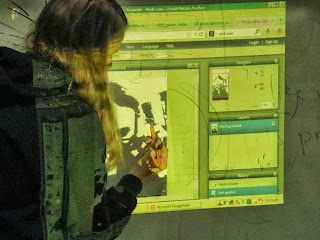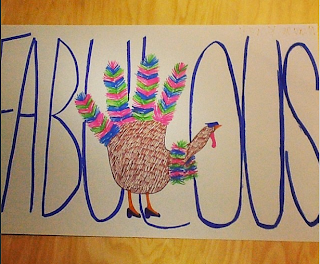Wednesday, December 11, 2013
Thursday, November 28, 2013
Hand Turkey Challenge
Inspired by Ms. Purtee's = "Hand Turkey Challenge" for her class, Ms. Sudkamp's Art 1s tried it out. What do you think?
 |
| #sassiest turkey |
 |
| Bob Ross as a hand turkey |
 |
| To boldly go where no turkey has gone before. |
Wednesday, November 27, 2013
How & Why I Use Choice In My Classroom - Part 3
This is part three of a week long series on choice in the art room...
By Kim Sudkamp
How I was introduced to the idea/What I first thought:
I've never been a fan of the "recipe" projects. Who made them? The teacher or the students? I've always encouraged my students to take the projects further, or put their own spin on it. Even when I was in the elementary classroom last year. But until I came to Apex high I hadn't heard of an open art classroom. Purtee and Sands introduced the idea. It seemed intimidating at first, but the more I thought about it, the more I realized it coincided with my beliefs on art education.
How I'm implementing choice in Sculpture:
The open art room is scary, there is no doubt about that. But it doesn't mean you don't have order or an understanding of materials.
These two student examples are from the same project and look nothing alike.
What about teaching techniques?
With each project theme and materials choice I provide a pinterest page to the students. The idea behind this is that the students can find what they need to know for their specific project while I provide more guidance.
Digital learning doesn't give a full spectrum of understanding materials that the students might need for their project. Seeing something and actually doing it are completely different. Every couple days I do a warm-up or demo for the students in the beginning of class. They can choose to use it this technique if it is appropriate for their project. For example, I did a throwing demo about a month ago with the project "pressure." 1 student chose the wheel. Currently the students are working on "Repetition," and 5 students have chosen the wheel. These students have used the Pinterest page, helped each other, as well as asked me for guidance in their work. These warm-ups are about learning the techniques that may later be used to achieve the conceptional idea within their work.
If you'd like to discuss this further you can reach me by:
- Commenting below
- Twitter
- email
PART 1 by Melissa Purtee
PART 2 by Ian Sands
PART 3 by Kim Sudkamp
PART 4
PART 5
By Kim Sudkamp
 |
| Student work - Self portraits (5th grade) |
I've never been a fan of the "recipe" projects. Who made them? The teacher or the students? I've always encouraged my students to take the projects further, or put their own spin on it. Even when I was in the elementary classroom last year. But until I came to Apex high I hadn't heard of an open art classroom. Purtee and Sands introduced the idea. It seemed intimidating at first, but the more I thought about it, the more I realized it coincided with my beliefs on art education.
How I'm implementing choice in Sculpture:
The open art room is scary, there is no doubt about that. But it doesn't mean you don't have order or an understanding of materials.
These two student examples are from the same project and look nothing alike.
 |
| "Relief Project" (Material Choice: Clay) |
 |
| "Relief Project" (Material Choice: Altered Book) |
I base each project around a theme. These themes change between a style of work ("relief") to conceptual ideas ("pressure"). I aim for these themes to be more open-ended and not limiting to material choices. My general template looks like this:
Based on this model I form my projects. My first project with my sculpture class was on "Vessels."
With each project theme and materials choice I provide a pinterest page to the students. The idea behind this is that the students can find what they need to know for their specific project while I provide more guidance.
Digital learning doesn't give a full spectrum of understanding materials that the students might need for their project. Seeing something and actually doing it are completely different. Every couple days I do a warm-up or demo for the students in the beginning of class. They can choose to use it this technique if it is appropriate for their project. For example, I did a throwing demo about a month ago with the project "pressure." 1 student chose the wheel. Currently the students are working on "Repetition," and 5 students have chosen the wheel. These students have used the Pinterest page, helped each other, as well as asked me for guidance in their work. These warm-ups are about learning the techniques that may later be used to achieve the conceptional idea within their work.
 |
| "Vessels Project" (Material Choice: Clay) |
 |
| "Vessels Project" (Material Choice: Other - Pencils) |
How I tackle project time:
Each material lends to specific a specific time range. In the beginning I had a difficulties with time management. As I watch students work on the assignment I see what material will probably take the longest. As the first student finishes, I introduce the next project. This might seem overwhelming, but as the student who is working on a more time consuming material they can also be thinking about their concept of the next. Due dates are very flexible in my classroom. If a student is constantly working I do not mind adding more time for them, but if a student is consistently off task I will give those students a hard deadline. This might seem unfair, but with each student I have a discussion about project timeline. They know what I expect. If a student rushes through a project I have them consider how they could improve it, and did they achieve the concept they were going for? These students if not ready to move onto the next project can work on their sketchbook assignment for the week. Using this model takes a lot of patience and student observation, but the students are self motivated becoming passionate about their own pieces. No longer do I hear "Oh, I trashed that, its stupid." or "Ugh! I hate working with clay!".JPG) |
| "Pressure Project" (Material Choice: Other - Wire/Tape/Ribbon) |
If you'd like to discuss this further you can reach me by:
- Commenting below
PART 1 by Melissa Purtee
PART 2 by Ian Sands
PART 3 by Kim Sudkamp
PART 4
PART 5
Sunday, November 17, 2013
Tuesday, November 5, 2013
Earth Works - Eco Friendly Art in the Classroom
Before it gets too cold my Art 1 & Sculpture classes completed a Land Art project.
We first checked out an amazing video by Tony Plant. This helped the students understand why art is created as well as introducing the idea of it being temporary. My Art 1 classes worked together as a table to create their pieces whereas the sculpture class worked individually. It was nice to see how their approaches to the project were so different.
Land Art Lesson
Thursday, October 17, 2013
Art 1 : Photoshop Head Swap
 |
| Obama's face on Bush's body |
 |
| Hipster Kitty Bear |
Tuesday, October 15, 2013
Stenciled Self Portrait
 Art 1 classes we have been working on stenciled self
portraits. After painting our background images (based off of
non-objections pieces) we edited photos of each students using
Pixlr.com. They changed the contrast and exposure of each image. In
doing so they were able to filter their images to the "art poster"
seting. Using the projector we traced the images to create our own
stencils.
Art 1 classes we have been working on stenciled self
portraits. After painting our background images (based off of
non-objections pieces) we edited photos of each students using
Pixlr.com. They changed the contrast and exposure of each image. In
doing so they were able to filter their images to the "art poster"
seting. Using the projector we traced the images to create our own
stencils. Layering the pieces helped show the positive and negative space. This project was successful for all ranges of art students.
Wednesday, September 11, 2013
Forced Perspective Photography
Perspective changes everything. I thought it might be fun to try something different this week. The kids have been working on their realism drawings for the past 2 weeks, I thought we'd try something else. Inspired by Ian Sand's post earlier this year we took a shot at forced perspective.
I introduced forced perspective photography as art that incorporates an opitcle illusion based on perspecitve. Students even watched a video on how they used this method in Lord of The Rings. If you'd like to see how they were introduced check them out here.
Subscribe to:
Posts (Atom)











.jpg)








.jpg)
















